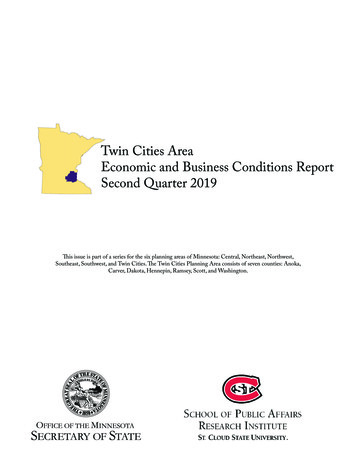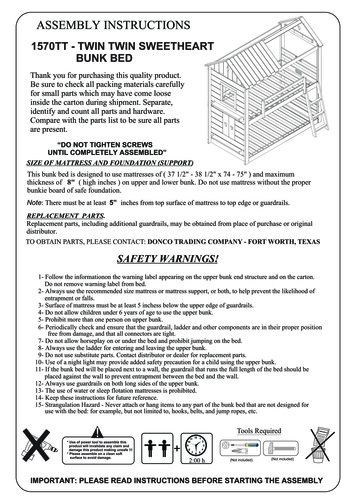
Transcription
Twin Cities AreaEconomic and Business Conditions ReportSecond Quarter 2019This issue is part of a series for the six planning areas of Minnesota: Central, Northeast, Northwest,Southeast, Southwest, and Twin Cities. The Twin Cities Planning Area consists of seven counties: Anoka,Carver, Dakota, Hennepin, Ramsey, Scott, and Washington.
TABLE OF CONTENTSExecutive Summary. 1Twin Cities Leading Economic Indicators Index. 2Twin Cities Business Filings. 4Minnesota Business Snapshot Survey Results. 9Maps. 15Twin Cities Labor Market Conditions. 17Twin Cities Bankruptcies. 22Economic Indicators. 23Sources. 25EXECUTIVE SUMMARYSteady economic growth is expected in the Twin Cities planning area according to the predictions of the Twin Cities Index ofLeading Economic Indicators (LEI). The Twin Cities LEI decreased 1.05 points in the second quarter of 2019 as two of the five indexcomponents registered negative values. A decrease in the number of new filings for incorporation and LLC, and a large drop in theFederal Reserve Bank of Philadelphia’s Minnesota Leading Economic Indicators Index series, caused the LEI to take on a negativevalue in this year’s second quarter. However, three LEI components made positive contributions to the leading index. An improvementin the Minnesota Business Conditions Index (a general measure of statewide business conditions), lower initial jobless claims in theregion, and increased residential building permits in the Twin Cities metropolitan area all favorably impacted the Twin Cities LEI inthe second quarter.There were 11,996 new business filings with the Office of the Minnesota Secretary of State in the seven-county metro area in thesecond quarter of 2019—representing a 3.6 percent increase from one year ago. 1,465 new regional business incorporations weretallied in the Twin Cities in the second quarter—3.1 percent higher than year ago levels. Second quarter new LLC filings rose to 7,905in the seven-county metro area—a 2.9 percent increase compared to the second quarter of 2018. New assumed names were 6.7 percenthigher in the second quarter and there were 15 fewer new non-profit filings in the Twin Cities than one year ago.53.8 percent of new business filers in the Twin Cities planning area completed the voluntary Minnesota Business Snapshot (MBS)survey in this year’s second quarter. Results of this voluntary survey indicate that 17.4 percent of new filers come from communitiesof color. 4.4 percent of new filings are veterans. 2.3 percent of new filers come from the disability community and 10 percent of newfilings are made by the immigrant community. Approximately thirty-eight percent of new business filings in the Twin Cities planningarea in this year’s second quarter were initiated by women. MBS results also show that most new business filers in the Twin Citieshave between 0 and 10,000 in annual gross revenues (although 684 new filers have revenues in excess of 50,000). The most popularindustries for new businesses in the Twin Cities are professional/scientific/technical, retail trade, construction, real estate/rental/leasing,and other services. Employment levels at most new firms are between 0 and 5 workers, and 45.1 percent of those starting a newbusiness consider this a part-time activity.Twin Cities planning area employment increased by 0.8 percent over the year ending June 2019. At 3.2 percent, the planning area’sunemployment rate was higher than one year earlier (when it was 2.8 percent). Initial claims for unemployment insurance were 6.3percent lower than year ago levels and the planning area’s average weekly wages rose by 2.4 percent to a level of 1,370. The planningarea’s labor force rose by 1.2 percent over the year ending June 2019. Average hourly earnings and average weekly work hours rose forprivate sector workers in the 16-county Minneapolis-St. Paul MSA. The year-over-year value of residential building permits decreasedby 15.6 percent in the Twin Cities MSA. The number of annual bankruptcies fell by 2.8 percent in the Twin Cities.1
TWIN CITIES Leading Economic Indicators IndexThe SCSU Twin Cities Leading Economic Indicators (LEI) index is designed to predict performance of the regional economy with afour-to-six month lead time. After a 0.70 point increase in this year’s first quarter, the Twin Cities LEI fell a modest 1.05 points in thesecond quarter of 2019. Note that three other Minnesota planning areas (northwest, southwest, and central) also experienced a declinein their leading economic indicators index in the second quarter.IndexSCSU Twin Cities Index of Leading Economic Indicators (December 1999 100)YearComponents of SCSU Twin Cities Leading Economic Indicators IndexComponent of IndexContribution to LEI, 2nd quarter 2019Contribution to LEI, 1st quarter 2019Twin Cities initial claims forunemployment .70Minnesota Business Conditions IndexTwin Cities new filingsof incorporation and LLCsMpls.-St. Paul MSA residentialbuilding permitsPhiladelphia Fed Minnesotaleading indicatorsTOTAL CHANGE0.232-1.41
Leading Economic Indicators IndexThe Twin Cities LEI contains five components—two reflecting state business conditions and three for local conditions (the LEI is anindex equal to 100 in December 1999). The Federal Reserve Bank of Philadelphia (which creates a leading economic indicator seriesfor each of the 50 states) reported a value for its Minnesota Leading Indicators series that made a significant negative contributionto the LEI this quarter. However, the Minnesota Business Conditions Index (constructed by Creighton University)—another generalindicator of statewide economic conditions—had a favorable impact on this quarter’s leading index. The regional initial jobless claimsseries also helped boost the LEI. The Twin Cities LEI was further boosted by increased single-family residential permits across theMinneapolis-St. Paul MSA, but was dragged down by lower new regional business filings of incorporation and LLC.SCSU Twin CitiesLeading Economic Indicators Index20192018Minnesota Business Conditions IndexJunePercentageChange53.458.8-9.2%Twin Cities initial claims for unemployment insuranceJune5,5395,909-6.3%Twin Cities new filings of incorporation and LLCsSecond 126.1-7.5%Twin Cities MSA single-family building permits, MarchIndex of Leading Economic IndicatorsPhiladelphia Federal Reserve, MarchTwin Cities Leading Economic Indicators IndexJune (December 1999 100)3
TWIN CITIES Business FilingsTotal new business filings in the Twin Cities planning area have generally trended upward since the second half of 2011. This strongupward trend has receded in the recent quarters, as new filings have leveled out. Second quarter new filings rose 3.6 percent to 11,996compared to one year earlier. The abrupt increase in new filings in the middle of 2008 is largely a result of increased new LLC filings.This outlier (resembling a shark fin) is related to considerably higher filings in the construction industry due to legal and regulatoryissues, and appears to be a one-time only transitory event seen in the data in all regions of Minnesota.Note: The graphs in this section show the 12-month moving total for the various new business filings in the Twin Cities that areregistered with the Office of the Minnesota Secretary of State. This adjustment removes seasonal patterns in the data.FilingsTotal New Business Filings—Twin Cities Planning Area (12-month moving total)YearQuarterTwin Cities TotalNew Business FilingsII:2018III:2018IV:2018I:2019II:20192019 Quarter II: Percentchange from prior year11,57810,65810,32111,99511,9963.6%4
Business FilingsNew business incorporations trended downward in the Twin Cities from 2005 to 2011, and then flattened out. At a level of 1,465,second quarter new filings of incorporation were 3.1 percent higher than one year earlier.FilingsNew Incorporations—Twin Cities Planning Area (12-month moving total)YearQuarterTwin Cities NewBusiness 019 Quarter II: Percentchange from prior year1,4211,3031,3611,4561,4653.1%5
Business FilingsThere has been a move in the Twin Cities (and the rest of the state) away from the traditional incorporation form of businessorganization toward LLCs. While new business incorporations remain an important indicator of new business formation in the TwinCities, LLCs are increasingly useful in evaluating regional economic performance. As seen below, there is a considerable upward trendin LLCs in the Twin Cities. With the exception of the outlier period in 2008-2009, new LLC formation has generally shown a fairlysteady rate of growth since 2005. At a level of 7,905, new filings for LLC in the second quarter of 2019 were 2.9 percent higher thanone year earlier. The moving total of this series now appears to be leveling out in 2019.FilingsNew Limited Liability Companies—Twin Cities Planning Area (12-month moving total)YearQuarterTwin Cities NewLimited 0192019 Quarter II: Percentchange from prior year7,6827,0826,7418,0157,9052.9%6
Business FilingsAssumed names, which include sole proprietors or organizations that do not have limited liability, rose by 6.7 percent in the secondquarter relative to the same period in 2018.FilingsNew Assumed Names—Twin Cities Planning Area (12-month moving total)YearQuarterTwin CitiesNew Assumed NamesII:2018III:2018IV:2018I:2019II:20192019 Quarter II: Percentchange from prior year2,0291,8451,7692,1082,1656.7%7
Business FilingsAfter bottoming out in 2010, the number of new Twin Cities non-profits registered with the Office of the Minnesota Secretary ofState has slowly increased to a level last seen in the mid-2000s. With 431 new non-profits registered in the second quarter, new filingsin this sector contracted by 3.4 percent compared to one year earlier.FilingsNew Non-Profits—Twin Cities Planning Area (12-month moving total)YearQuarterTwin CitiesNew Non-ProfitsII:2018III:2018IV:2018I:2019II:20192019 Quarter II: Percentchange from prior year446428450416431-3.4%8
MINNESOTA BUSINESS SNAPSHOT SURVEY RESULTSIn Fall 2016, the Office of the Minnesota Secretary of State initiated a short voluntary survey (known as Minnesota BusinessSnapshot) for both new and continuing business filers. Questions found in the survey address basic questions related to thebackground of business filers, industry classification, employment levels and annual revenue of the filer, and whether the business is afull- or part-time activity for the filing entity. While a comprehensive analysis of this promising new data set is the beyond the scopeof this regional economic and business conditions report (an annual report of the Minnesota Business Snapshot is available from theOffice of the Minnesota Secretary of State), the survey results do provide useful additional background information to complement thebusiness filing data.To match up the Minnesota Business Snapshot (MBS) information with the data analyzed in this report, only surveys accompanyingnew filings in the second quarter of 2019 are analyzed. For the entire State of Minnesota, the overall response rate for this voluntarysurvey is approximately 55 percent. This yields thousands of self-reported records in this emerging data set. For the Twin Cities, 53.8percent of new business filers also completed at least some portion of the MBS survey. The results are reported in this section.17.4 percent of those new filers completing the MBS from the Twin Cities planning area report being from a community of color. Thisis more than twice the rate recorded in any of the other planning areas in the state.9
Minnesota Business Snapshot Survey ResultsA small percentage of Twin Cities’ new filers—2.3 percent—are from the disability community.10 percent of new business filings in the Twin Cities come from the immigrant community. This is a considerably higher rate than isfound in other Minnesota planning areas.10
Minnesota Business Snapshot Survey Results4.4 percent of new filings in the Twin Cities come from military veterans. As has been observed in previous reports, this is one of thelowest rates of Minnesota’s six planning areas.Woman owners represented 38.2 percent of the new business filings in the Twin Cities in the second quarter of 2019.11
Minnesota Business Snapshot Survey ResultsWhile not all of those participating in the survey completed all portions of the Minnesota Business Snapshot (those not responding toa particular question are represented in this section by “NAP”—no answer provided), 6,297 responses were tallied to a question askingthe new business filer to indicate the range of employment at the business. As expected, most new businesses start small—employmentat most companies submitting a new filing ranges from 0-5 employees.12
Minnesota Business Snapshot Survey ResultsUsing the North American Industry Classification System (NAICS), businesses submitting new filings were asked to identify theindustry in which their company was operating. While a range of industries were reported, professional/scientific/technical services,retail trade, construction, real estate/rental/leasing, and “other services” lead the way. Since businesses are often unsure of their industrialclassification, the “other services” category is likely to represent a “catch-all” category for service-related businesses who were unable tospecify their industry. 500 new firms did not provide an answer to this survey item (see “NAP”).13
Minnesota Business Snapshot Survey Results45.1 percent of those submitting a new business filing in the Twin Cities are part-time ventures.1,829 new business filers in the Twin Cities did not provide an answer to the MBS item that asked them to report the company’srevenue. Of those businesses that answered the question, the largest share report revenues of less than 10,000. 684 firms reportrevenues in excess of 50,000.14
MapsThe first map shown below is a visual representation of new business formation around the Twin Cities planning area in the secondquarter of 2019. The densest areas of new business formation are concentrated in the middle of the planning area, although virtuallyall portions of the area experienced some type of new business formation. Well-traveled roadways are a predictor of new businessformation in the Twin Cities planning area.Twin Cities Planning Area--New Business Formation--Quarter 2: 201915
MapsThe second map shows new business filings for the state as a whole. This visual aid demonstrates the considerable extent to which theTwin Cities metro area dominates new business formation in the state. The map shows how the Twin Cities metro stretches alongroadways into the Southeast, Southwest and Central planning areas. The map demonstrates the importance of cities and roadways inencouraging economic development. St. Cloud now appears to be integrated into the Twin Cities metro as the I-94/US-10 corridorcontinues to be a magnet for new business formation. There is also considerable new business formation in the southern part of thestate, particularly in Rochester and between the Twin Cities and Mankato. The importance of Interstates 90, 94 and 35 as well as US10 and MN 61 (along the North Shore) in new business filings is also easily seen in this map.Minnesota--New Business Formation--Quarter 2: 201916
TWIN CITIES Labor Market ConditionsEmployment of Twin Cities planning area residents increased 0.8 percent over the past year. After a decline during the GreatRecession, the area has experienced fairly steady employment growth since the start of 2010. However, the 12-month moving averageof Twin Cities planning area employment appears to have leveled out in recent quarters.Note: seasonally adjusted labor market data are typically not available to evaluate regional economic performance. While there areseasonally adjusted labor market data for the Twin Cities metro area, these data include parts of Wisconsin. These seasonally adjusteddata therefore do not accurately capture the Twin Cities planning area (which is confined to seven counties). Some graphs of labormarket indicators found in this section of the report are adjusted so as to remove seasonal patterns from the data. Tabular data are notseasonally adjusted.EmploymentEmployment—Twin Cities Planning Area (12-month moving average)YearMonthEmployment(Not 21,662,6581,661,4941,666,9661,670,9221,684,80217
Labor Market ConditionsUntil flattening out in 2015, the seasonally adjusted unemployment rate in the Twin Cities had declined since the end of the GreatRecession. However, the accompanying graph shows the seasonally adjusted unemployment rate once again declined beginning in2017. This series has now turned upward since the last quarter of 2018. The non-seasonally adjusted unemployment rate now stands at3.2 percent, considerably higher than the 2.8 percent rate recorded in June 2018.Unemployment RateUnemployment Rate, seasonally adjusted—Twin Cities Planning AreaYearMonthUnemployment Rate(Not seasonally %18
Labor Market ConditionsNew claims for unemployment insurance were 6.3 percent below year ago levels in June 2019. The graph of the seasonally adjustedseries suggests claims began to level out in 2018.ClaimsTotal Initial Claims for Unemployment Insurance, seasonally adjusted—Twin Cities Planning AreaYearPeriodInitial claims(Not seasonally ,7015,53919
Labor Market ConditionsThe Twin Cities planning area enjoys the highest average weekly wages in the state. With an average weekly wage of 1,370, TwinCities wages are 36.2 percent higher than the planning area with the second highest wages (the Southeast Minnesota planning area,where the average weekly wage is 1,006). Twin Cities average weekly wages were 2.4 percent higher in the first quarter (this is themost recently available data) than they were one year earlier.WagesAverage Weekly Wages---Twin Cities Planning 19:IAverage Weekly Wages 1,190 1,240 1,217 1,318 1,338 1,37020
Labor Market ConditionsThe size of the Twin Cities labor force grew by 1.2 percent over the past twelve months. The 12-month moving average (seeaccompanying graph) of the Twin Cities labor force has risen fairly steadily since the end of the Great Recession.Labor ForceLabor Force—Twin Cities Planning Area (12-month moving average)YearYear ( June)Labor Force(Not seasonally 81,685,8891,711,4391,719,9411,741,34121
BankruptciesTWIN CITIES BANKRUPTCIESThe figure below shows the 12-month moving total for Twin Cities bankruptcies since the second quarter of 2007 (shortly beforethe beginning of the Great Recession). As can be seen in the figure, this moving total increased through the second quarter of 2010,and generally declined until the beginning of 2016, at which time it began leveling out. With 5,735 bankruptcies over the past twelvemonths, the annual number of bankruptcies reported in the Twin Cities is 2.8 percent lower than it was one year ago (when 5,900annual bankruptcies were reported).BankruptciesTwin Cities Bankruptcies (12-month moving total)QuarterYear (Second Quarter)Annual Bankruptcies(not seasonally 8775,9005,73522
Economic IndicatorsTwin Cities MSAIndicatorsPeriod CoveredCurrentPeriodPrior YearAnnual PercentChangeLong Term Average(since 1999 unlessnoted)EmploymentJune 2019 (m)2,042,3192,033,2410.4% 0.7%Manufacturing EmploymentJune 2019 (m)203,388200,8641.3% -0.9%Average Weekly Work HoursJune 2019 (m)-Private Sector35.234.90.9% 34.4(since2007)June 2019 (m) 31.18 29.675.1% 1.6%(since2007)Average Weekly Work Hours-Manufacturing (ProductionJune 2019 (m)Workers)40.841.7-2.2% 40.8(since2005)(since2005)Average Earnings Per Hour-Private SectorAverage Earnings Per Hour-Manufacturing (ProductionWorkers)June 2019 (m) 23.89 21.929.0% 2.0%Unemployment RateJune 2019 (m)3.3%2.8%NA 4.5%Labor ForceJune 2019 (m)2,033,9962,037,455-0.2% 0.7%MSP Residential BuildingPermit ValuationJune 2019 (m)352,507417,516-15.6% NAMinneapolis Cost of LivingIndexSecond Quarter 2019 (q)106.5104.91.5% NASt. Paul Cost of Living IndexSecond Quarter 2019 (q)107.4104.52.8% NA(m) represents a monthly series(q) represents a quarterly seriesThe Minneapolis-St. Paul Metropolitan Statistical Area (an MSA is a grouping of counties and municipalities identified by the Censusas having economic and demographic forces in common) includes 14 Minnesota counties (the definition of the MSA was recentlyexpanded to include Le Sueur, Mille Lacs, and Sibley counties): Anoka, Carver, Chisago, Dakota, Hennepin, Isanti, Le Sueur, MilleLacs, Ramsey, Scott, Sherburne, Sibley, Washington and Wright. This MSA also includes the Wisconsin counties of Pierce and St.Croix. It is thus much larger than the seven-county Twin Cities planning area. Still, activity outside of the area influences economicbehavior within it, and vice versa. The larger Minneapolis-St. Paul MSA experienced mixed economic performance over the past 12months. Overall employment rose in the Twin Cities MSA (and manufacturing employment also expanded). Average hourly earningsrose in the private sector (as well as for production workers), and average weekly work hours rose in the private sector. However, theTwin Cities MSA unemployment rate was higher and the labor force contracted. The value of residential building permits in the TwinCities MSA experienced a 15.6 percent year-over-year increase compared to June 2018. The relative cost of living in both Minneapolisand St. Paul also rose.23
Economic IndicatorsSTATE AND NATIONAL INDICATORSMINNESOTA IndicatorsNonfarm payroll employment, SAJun 2019Mar 2019Jun 2018Changefrom onequarter Average weekly hours worked, private sector34.533.434.13.3%1.2%Unemployment rate, seasonally adjusted3.3%3.2%2.8%NANAEarnings per hour, private sector 29.92 29.85 28.770.2%4.0%Philadelphia Fed Coincident Indicator, MN138.54138.12137.150.3%1.0%Philadelphia Fed Leading Indicator, MN1.00-0.112.59NA-61.4%Minnesota Business Conditions Index53.453.058.80.8%-9.2%Price of milk received by farmers (cwt) 18.20 17.80 16.302.2%11.7%Enplanements, MSP airport, thousands1,827.51,778.31,753.02.8%4.2%Changefrom onequarter agoAnnualChangeNATIONAL IndicatorsNonfarm payroll employment, SA, thousandsJun 2019Mar 2019Jun 2018151,267150,796149,0070.3%1.5%Industrial production, index, SA109.6109.7108.2-0.1%1.3%Real retail sales, SA, millions ( )203,633202,090200,1670.8%1.7%Real personal income less transfers, billions14,144.014,042.713,704.40.7%3.2%Real personal consumption expenditures, bill.13,270.213,162.212,946.20.8%2.5%Unemployment rate, SA3.7%3.8%4.0%NANANew building permits, thousands of units111.0105.7123.35.0%-10.0%Standard and Poor's 500 stock price index2,890.22,804.02,754.43.1%4.9%Oil, price per barrel in Cushing, OK 54.66 58.15 67.87-6.0%-19.5%Economic performance found in the State and National Indicators table is mostly favorable. For the state as a whole, there was growthin employment and improved earnings over the past year. Hours worked rose, while enplanements at the Minneapolis-St. Paul airportwere higher. Milk prices rose. The Federal Reserve Bank of Philadelphia’s Coincident Indicators series was higher, but its leadingeconomic indicators fell. The state’s seasonally adjusted unemployment rate rose and the Minnesota Business Conditions index waslower than one year ago.The national economic indicators found in the table are largely favorable. Employment, income, industrial production, retail sales andconsumer spending are all improved over the past twelve months (although one of these measures experienced a quarterly decline), andthe unemployment rate is lower. Stock prices have rebounded from their low point at the end of 2018. However, new building permitsare lower than they were in last year’s second quarter. Oil prices fell in the second quarter, and are considerably lower than one year ago.24
SourcesThe Twin Cities Quarterly Economic and Business Conditions Report is a collaboration between the Office of the MinnesotaSecretary of State and the School of Public Affairs Research Institute (SOPARI) of St. Cloud State University. All calculationsand text are the result of work by SOPARI, which is solely responsible for errors and omissions herein.Text authored by Professors King Banaian and Rich MacDonald of the Economics Department of St. Cloud State University.Research assistance provided by Nicholas Gross Kotschevar. Professor David Wall of the SCSU Geography Department providedGIS assistance.SourcesCouncil for Community and Economic Research: Cost of Living Index.Creighton University Heider College of Business: Minnesota Business Conditions Index, Rural MainStreet Index.Federal Reserve Bank of Philadelphia: Minnesota Coincident Indicator Index, Minnesota Leading Indicators Index.Federal Reserve Board of Governors: Industrial Production.Institute for Supply Management: Manufacturing Business Survey, Purchasing Managers Index.Metropolitan Airports Commission: MSP Enplanements.Minnesota Department of Employment and Economic Development (and U.S. Department of Labor Bureau of Labor Statistics): AverageHourly Earnings, Average Weekly Work Hours, Employment, Initial Claims for Unemployment Insurance, Job Vacancies, Labor Force,Manufacturing Employment, Unemployment Rate.Office of the Minnesota Secretary of State: Assumed Names, Business Incorporations, Limited Liability Companies, Non-Profits.Standard & Poor’s: Standard & Poor’s 500 Stock Price Index.Thomson Reuters and University of Michigan, Index of Consumer SentimentU.S. Bankruptcy Courts: BankruptciesU.S. Bureau of Census: Durable Goods Orders, Housing Permits, Residential Building Permits, Retail Sales.U.S. Department of Agriculture: Milk Prices.U.S. Department of Commerce Bureau of Economic Analysis: Real Personal Consumption, Real Personal Income, Real Wages and Salaries.U.S. Energy Information Administration: Oil Prices.25
Twin Cities initial claims for unemployment insurance Twin Cities new filings of incorporation and LLCs Twin Cities MSA single-family building permits, March 914 861 6.2% Index of Leading Economic Indicators Philadelphia Federal Reserve, March 1.00 2.53 -60.5% Twin Cities Leading Economic Indicators Index June (December 1999 100) 116.7 126.1 .










